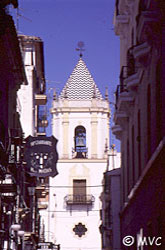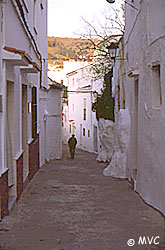 |
| Calle Pedro Romero in Ronda |
Ronda is divided into three parts, and the old Moorish citadel, La Ciudad, should be explored first. If, like most visitors, you drive up from the coast, the first part of town you will encounter is the Barrio de San Francisco. Park here, and enter the fortifications on foot through the Moorish gate, the Puerta de Almocábar, with its characteristic horseshoe arch. This was the main entrance to the city and was once protected by towers, now gone.
On the corner of the defences, overlooking the flank of the Puerta de Almocábar, the Almohad rulers erected the octagonal tower which fell victim to the Christians' cannon fire during their successful assault in 1485. The place is now marked by the Iglesia del Espiritu Santo, the church built by the Christians to celebrate their victory on Whit Sunday, May 20th 1485; the day appointed by tradition to mark the coming of the Holy Spirit to the disciples after Christ's crucifixion and ascension into Heaven. Perhaps surprisingly, considering the magnitude of the triumph it was built to commemorate, it is a simple, unpretentious building with only a single nave.
Before moving on and leaving the outer defences behind, take note of the other surviving horseshoe arch to the west, the Arco de Cristo. Clearly, though allowed to survive (Christians needed defending too), its original and now lost name was rapidly changed.
Book your stay in Andalucia Now!
As you walk on into the old city, you will pass a small Moorish minaret now known as the Minaret of San Sebastián. Oddly, after the expulsion of the Arabs this tenacious structure switched allegiance and lived on as the belfry of a church. The church is now gone, but the minaret continues miraculously to survive. There is irony here for those who seek it.
 |
|
Street in Ronda
|
The old city walls are still in existence and visitors can climb and walk along them towards the bridge, passing through the more modern and merely decorative Puerta Felipe V. Visible below, still safe inside its walled garden, is the beautifully preserved Moorish bath house, the Hammam. In its heyday, the bath house drew water directly from the nearby stream. It has been tidied up, and is open to the public without charge though not, of course, for the purposes of bathing. The barrel vaults are pierced with star-shaped holes to allow illumination, and this is an excellent place to pause and feel the weight of Ronda's years.
From the Puerta Felipe V, it is possible to see the lower bridge, the Puente Romano. Don't be fooled by its name. Although there may well have been a Roman bridge here at some time in the distant past, the bridge as it exists today is undoubtedly a Moorish construction, much restored. Overlooking Puente Romano is another Moorish bridge whose origins are hidden beneath its extensive rebuilding in 1616. The Puente Viejo, or Old Bridge, is so called to distinguish it from Ronda's most famous bridge of all, the Puente Nuevo, across which millions of tourists trudge each year.
Inside La Ciudad, there are a number of surviving Moorish houses and minor palaces open to visitors.
GPS Location: 36º 44' 04"N 5º 09' 53"W View on Google Maps